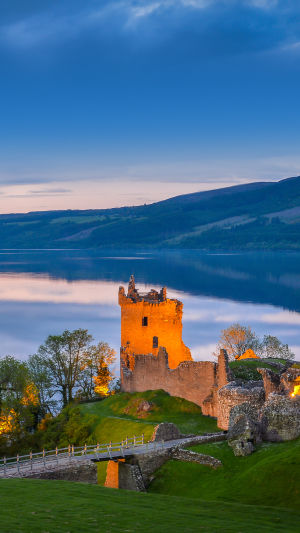Located in the heart of the Scottish Highlands, Loch Ness is one of the largest freshwater lakes in Scotland and one of the famous tourist attractions. Loch Ness is about 37 kilometers long, about 1.6 kilometers wide at its widest point, and 230 meters deep at its deepest point, with a water area of about 56.4 square kilometers.
There are magnificent natural scenery and rich wildlife around the lake, especially the mysterious creature that is said to be hidden in the lake - the Loch Ness Monster.
The Loch Ness Monster, known as the "Loch Ness Water Dragon", is a mysterious creature in the Scottish Highland legend, and it has been said to have a history of hundreds of years.
According to legend, its body is as long as a snake, its head is similar to that of a dinosaur, its body is covered with thick scales, and it seems to have a pair of wings.
Although people have claimed to have witnessed the Loch Ness monster for many years, the scientific community is sceptical about its authenticity, and there is still no conclusive evidence to prove its existence.
In addition to the Loch Ness monster, Loch Ness also attracts many tourists to visit. Tourists can take a boat tour of the lake to enjoy the beautiful scenery of the lake and the legendary water monster; they can also visit museums in small towns by the lake to learn about the history and legends of the Loch Ness monster; in addition, there are many hiking routes by the lake, and tourists can walk Explore the natural surroundings.
The Loch Ness area has its own characteristics throughout the year, but the best tourist season is in summer, from June to August. During this season, the weather is usually mild with more comfortable temperatures, less rain, more sunshine, and plenty of daylight hours, which is also the best time for swimming and outdoor activities.
If you prefer to avoid peak tourist season and crowds, head to the Loch Ness area in spring (March to May) or autumn (September to November). Temperatures are cooler during these seasons, but the scenery is still stunning, there are fewer tourists, and the prices may be better. However, it should be noted that the weather in the Loch Ness area is more unstable in spring and autumn, and there may be showers and cloudy days.
Winter (December to February) usually has more snowfall in the Loch Ness area, but it is also a good time for some outdoor sports enthusiasts to go skiing and snowshoeing. However, it should be noted that the road surface may be affected by ice and snow in winter, so you need to pay attention to safety.
Besides Loch Ness and the Loch Ness Monster, there are plenty of other things to see and do in the Scottish Highlands. Here are some examples:
The natural scenery of the Scottish Highlands: The Scottish Highlands have magnificent natural landscapes, such as magnificent mountains, lakes, waterfalls, coastlines, etc. Among the most famous attractions are Ben Nevis, Glencoe Highland Park, Celtic Cross, West Coast, etc.
Castles and museums: There are many historic castles and museums in the Scottish Highlands, such as Inverness Castle, Stirling Castle, Aberdeenshire Museum, etc. Visitors can learn about the history and culture of the Scottish Highlands.
Activities and experiences: There are also many activities and experiences in the Scottish Highlands such as hiking, kayaking, fishing, golf, skydiving, horse riding, and more. Visitors can enjoy a variety of different outdoor activities and experiences.
Food and drinks: There are many food and drinks in the Scottish Highlands, such as Scottish roast lamb, black pudding, seafood, and so on. Visitors can taste local specialities and drinks, and learn about the culture and traditions of the Scottish Highlands.





